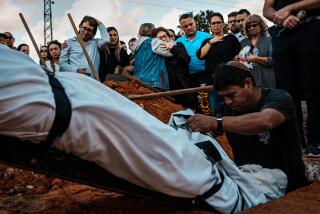By whom the toll is counted
- Share via
Stone Mountain, Ga. — NO one asked Michael White to count the dead soldiers in Iraq.
He is not a military man, and he has no friends or relatives who serve. He is a guy with a Honda Civic, a mortgage and a job in a suburban office park. A guy with a wife and a 7-year-old daughter who has soccer games to go to.
But for almost 3 1/2 years -- for no pay and no glory -- White has kept a meticulous tally of every U.S. and coalition military fatality, posting the names and the numbers on his website, www.icasualties.org.
It started as a hobby -- the work of a war critic who wanted to help keep the facts straight. Today, the Los Angeles Times, Washington Post and New York Times use White’s numbers to show the extent of the nation’s collective sacrifice. Bloggers use his numbers to quell conspiracy theories, and soldiers’ parents call up the site to make sure their children are not listed on it. Job seekers have sent him resumes, unaware that the operation is little more than a guy and his laptop.
White is a former post-punk guitar player who, at age 50, favors khakis and sensible shoes. He is proud of his work, and pleased that people are paying attention. But like many Americans, he doesn’t know when the war will end -- and he wonders how long the site will dominate his life.
He has been particularly busy of late. His own statistics show that October was the deadliest month for U.S. forces in Iraq since January 2005, with 105 fatalities. This month, as of Tuesday, 35 more troops have died. The total number of American military fatalities stands at 2,853. It will surpass the 3,000 mark in a few months if current trends hold.
“I work on the site every morning, every lunch, every evening,” White said. “I’m sure my wife resents it, as well she should.... There’s housework that doesn’t get done. There’s yardwork that doesn’t get done.”
His wife, Ashley, admits that his obsession can be frustrating. “When I want to do something fun on the weekends, it competes with his work on the site,” she said. “On the other hand, I’m very proud of him for his commitment.”
Like most Americans with scant ties to the war effort, White could have kept its grisly rhythms at a distance. Instead, those rhythms now define him. And yet Iraq can still seem worlds from his tidy suburban cul-de-sac, and the breakfast nook where he does most of his work on a round wooden table. A window behind him offers a view of the train tracks where, about year ago, he remembers seeing a train loaded with Humvees -- a rare reminder of life during wartime.
AND even now, White can seem unsure about his motivation for assuming his peculiar burden.
“Why do I do it? If you ask my mother or my sister, they’d say, ‘That’s Michael: obsessive,’ ” he said. “It’s like when I was 14 years old and locked myself in my bedroom to memorize every word to [Bob Dylan’s] ‘Like A Rolling Stone.’ ”
White is of average height, with an open, sanguine face and a measured voice that is both soft and firm. He is a Southern liberal who never considered himself an activist, but he has long had an interest in politics and current events. He traces it to his upbringing in South Carolina, where he lived through the tension of desegregation.
His most reliable passion, however, has always been music. When George W. Bush was elected president in 2000, he retreated into the “Anthology of American Folk Music,” the Harry Smith-compiled landmark of the genre, immersing himself in its crackly old spirituals and Scots-Irish murder ballads.
His reaction to Iraq was different. About two months after the U.S.-led invasion in March 2003, White discovered that a California antiwar protester named Pat Kneisler had posted a self-researched tally of troop casualties on Daily Kos, a pro-Democratic website. Like White, Kneisler had been frustrated by differing fatality counts in the media.
White contacted her and offered to keep the count going on his own site, lunaville.org-- the name for the make-believe city where he set his daughter’s bedtime stories.
Kneisler accepted the offer, and the pair set about their common task from different sides of the country. For White, it was a protest, albeit a low-key sort that suited his personality.
“I’m not the kind of person who will stand on a street corner holding a sign,” he said. “Maybe I’d be a better person if I was.”
Then, as now, the Department of Defense kept its own tally of U.S. casualties on its website, www.defenselink.mil. But White and Kneisler were concerned that the numbers were updated slowly, and didn’t seem to be consistent in media accounts.
“The concept from the get-go was to get an accurate count,” White said. “I’d pick up the morning paper and it would say the number was X, and then I’d hear a news report that said five more troops had been killed. But the next day in the paper the number was still X. It was always behind, and I wanted to know what the immediate tally was.”
The pair used official military news releases for their list, cross-checking them with reports from journalists who were traveling with coalition troops. Over time they earned a reputation among media and military families for being accurate and quick to update their figures.
THE traffic to the site soon overwhelmed White’s home server. When he switched to a commercial host, the traffic outstripped his subscription plan: At one point, he ended up with a $1,000 monthly bill. So he changed the terms of his subscription and put up a request for donations. Today, donors keep the bills paid.
There were more changes as the war dragged on. The name “icasualties” supplanted “lunaville.” (“Yeah,” Ashley said. “Some bedtime story, huh?”) They added links to news stories, and began counting casualties in Afghanistan.
Kneisler dropped out of the project in April without explaining her reasons to White. She would not comment for this story. In the past, White said, they had argued over whether to post the name of a soldier who had been run over by a car while on leave back in the United States. He refused to include the fatality in the official count because it wasn’t war-related.
White added features that packaged the casualty numbers -- on the wounded as well as the dead -- in ways that the Pentagon had not. The idea, he said, was to generate the kind of detailed data that corporate executives demand for their board meetings.
One map shows the number of coalition and U.S. deaths that occurred in each Iraqi province. It reveals that Al Anbar province, the largest in the nation and a stronghold of Sunni Muslim insurgents, has seen at least 1,044 coalition deaths, making it a deadlier place than Baghdad province, with at least 746 deaths. Some fatalities, the website notes, cannot be identified by province.
Some of the charts focus on fatalities among non-U.S. coalition troops: of the 246 killed, 125 were from the United Kingdom, 33 from Italy, and Poland and Ukraine have each lost 18. Another chart shows the number of U.S. troops killed each month by roadside bombs, known as improvised explosive devices, or IEDs.
SOME of the information on White’s site, such as the number of U.S. deaths per state, is also available from the Defense Department, but White often updates his numbers faster. And his information, arguably, is easier to find: For one, the government’s state-by-state fatality breakdown is accessible at a much more unwieldy URL (https://siadapp.dior.whs.mil/personnel/CASUALTY/castop.htm).
And White goes one step further. He also breaks down the number of deaths by city.
Those kinds of details are among the chief attractions for journalists. In September, the New York Times used White’s figures to show that Houston, at the time, had sacrificed more soldiers in Iraq and Afghanistan than any other city, 27. (With the death of Marine Cpl. Benjamin S. Rosales in Iraq in October, that number is now 28).
On Oct. 19, USA Today used icasualties.org’s numbers to show the five deadliest days in Iraq thus far in 2006. (The deadliest was Jan. 7, when 18 U.S. troops were killed -- nine of them in a helicopter crash).
Marine Corps Maj. Stewart T. Upton, a Defense Department spokesman, said he hadn’t heard of the site before. “People should look to the Department of Defense for the official numbers,” he said.
The essence of White’s work starts with his search for casualty news releases from the coalition, the Multi-National Force-Iraq. The releases, available at its website, www.mnf-iraq.com, contain minimal details of the death -- typically, its date and location, and what branch of the military the troop was in, and the cause.
White posts these deaths in his main database as “NAME NOT RELEASED YET”, and counts them as “Reported U.S. Deaths Pending DoD Confirmation.”
Then he goes to the Department of Defense website, where a more detailed news release is made public 24 hours after the family is notified. These generally contain the deceased’s name, age, rank, hometown and a more thorough description of the cause of death.
When a specific news release matches a generic one, White fills in the details. It is these details that allow him to generate many of his original charts and graphs. But sometimes the generic and the specific news releases do not match up. Checking against details in news reports has become more difficult, he said, because fewer reporters appear to be traveling with military units. Instead, some of his best fact-checkers are the military personnel and families who use the site.
THOSE families visit for different reasons. Diane Santoriello, 57, of Penn Hills, Pa., checks icasualties.org every morning, writing the latest casualty count on a sticky note she posts on her computer.
Santoriello lost her son, Army 1st Lt. Neil A. Santoriello, in August 2004 when he was killed by an IED outside of Fallouja, in Al Anbar province. She has become an outspoken critic of the war. She says she misses the time she spent writing to him on her computer.
“I think part of it is a replacement for e-mailing him,” she said.
Elsa De La Fuente, 49, of Miami, first visited the site about two months ago. A few weeks had gone by, and she hadn’t heard from her 27-year-old son, stationed in or around Tikrit. She was relieved to find that his name was not on the list.
De La Fuente checks the site regularly. She said she preferred its presentation of cold facts to the emotionally charged images she had to endure on television and in newspapers.
“The statistics will show you,” she said. “You don’t need to shoot pictures or anything.”
White has kept his site free of politics -- largely because he has learned how much the families of troops rely on his numbers.
“It’s awful hard to read those e-mails,” he said. “You have to acknowledge their loss in a nonpartisan way. That’s one reason the site’s agenda is separate from my politics. It’s documentary. It doesn’t have a political agenda. It answers a question I want answered.”
But some questions are easier to answer than others. White also has been trying to keep track of Iraqi civilian deaths, tallying the numbers from news reports. But he knows it’s not an accurate way to count, and his numbers only go back to January 2005.
His chart lists 19,526 Iraqi civilians killed since that date. Below that total, a sentence in red type says “Total Prior to 2005,” followed by a question mark.
“This is not a complete list,” the site states, “nor can we verify these totals.”
His list of private contractors who died in Iraq carries a similar disclaimer. It is one of the few collections of its kind that is publicly available.
But so far he has found only 370 names by scouring news reports. The Department of Labor has tallied 650 such deaths through late October, but will not release the names for reasons of confidentiality.
And so White’s work continues. There is a Starbucks near his office with Wi-Fi. Sometimes he glances down at the newspapers for sale and sees his numbers splashed across the front page.
Sometimes the faux bossa nova plays and the milk foam whooshes, and the world seems at peace, but for the clack of Michael White’s keyboard.
More to Read
Sign up for Essential California
The most important California stories and recommendations in your inbox every morning.
You may occasionally receive promotional content from the Los Angeles Times.













